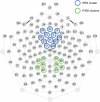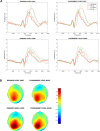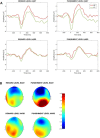Brain potentials reveal reduced attention and error-processing during a monetary Go/No-Go task in procrastination
- PMID: 33184299
- PMCID: PMC7661523
- DOI: 10.1038/s41598-020-75311-2
Brain potentials reveal reduced attention and error-processing during a monetary Go/No-Go task in procrastination
Abstract
Procrastination is a self-regulatory problem of voluntarily and destructively delaying intended and necessary or personally important tasks. Previous studies showed that procrastination is associated with executive dysfunctions that seem to be particularly strong in punishing contexts. In the present event-related potential (ERP) study a monetary version of the parametric Go/No-Go task was performed by high and low academic procrastinators to verify the influence of motivational context (reward vs. punishment expectation) and task difficulty (easy vs. hard) on procrastination-related executive dysfunctions. The results revealed increased post-error slowing along with reduced P300 and error-related negativity (ERN) amplitudes in high (vs. low) procrastination participants-effects that indicate impaired attention and error-related processing in this group. This pattern of results did not differ as a function of task difficulty and motivation condition. However, when the task got more difficult executive attention deficits became even more apparent at the behavioral level in high procrastinators, as indexed by increased reaction time variability. The findings substantiate prior preliminary evidence that procrastinators show difficulties in certain aspects of executive functioning (in attention and error processing) during execution of task-relevant behavior, which may be more apparent in highly demanding situations.
Conflict of interest statement
The authors declare no competing interests.
Figures






References
-
- Mischel W. Processes in delay of gratification. Adv. Exp. Soc. Psychol. 1974;7:249–292.
-
- Nigg JT. Annual research review: On the relations among self-regulation, self-control, executive functioning, effortful control, cognitive control, impulsivity, risk-taking, and inhibition for developmental psychopathology. J. Child Psychol. Psychiatry. 2017;58:361–383. doi: 10.1111/jcpp.12675. - DOI - PMC - PubMed
Publication types
MeSH terms
LinkOut - more resources
Full Text Sources
Miscellaneous

